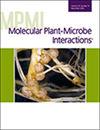Pablo A Gutierrez, Joshua Fuller, Sydney Stroschein, Austin VanDenTop, Dennis Halterman, Aurélie M Rakotondrafara
求助PDF
{"title":"马铃薯Y病毒在共侵染过程中抑制茄交菌生长。","authors":"Pablo A Gutierrez, Joshua Fuller, Sydney Stroschein, Austin VanDenTop, Dennis Halterman, Aurélie M Rakotondrafara","doi":"10.1094/MPMI-03-25-0026-R","DOIUrl":null,"url":null,"abstract":"<p><p>In the environment, multiple microbes can interact with each other in the plant phyllosphere. These associations can shape the plant's development, stress responses, and disease susceptibility, but the molecular mechanisms that govern this process remain unexplained. Of interest are the multiple or successive infections that crop plants are exposed to within a growing season. One of the most common and economically important viruses of potato is potato virus Y (PVY, <i>Potyviridae</i>). We show that PVY infection of potato limited the expansion of foliar necrotic lesions caused by the early blight fungus <i>Alternaria solani</i>. The reduced growth phenotype persisted when the fungal mycelium was transferred to solid growth media. RNA-seq analysis of responses in potato and <i>A. solani</i> to the presence of PVY suggested two mechanisms that can explain this interaction. First, in <i>A. solani</i> exposed to PVY-positive leaves, we observed a downregulation of fungal pathogenicity genes. Second, we found that, in the absence of PVY, <i>A. solani</i> downregulates ethylene-responsive defense in potato, but this effect was eliminated when the host was infected with PVY. Our findings expand our understanding of how pathogen virulence can be affected by other pathogens competing for the same host resources. The observation that PVY can alter <i>A. solani</i> infection illustrates the ecological role of viruses as a potential contributor to the development of disease outbreaks. [Formula: see text] Copyright © 2025 The Author(s). This is an open access article distributed under the CC BY-NC-ND 4.0 International license.</p>","PeriodicalId":19009,"journal":{"name":"Molecular Plant-microbe Interactions","volume":" ","pages":"543-556"},"PeriodicalIF":3.4000,"publicationDate":"2025-07-01","publicationTypes":"Journal Article","fieldsOfStudy":null,"isOpenAccess":false,"openAccessPdf":"","citationCount":"0","resultStr":"{\"title\":\"Potato Virus Y Restricts <i>Alternaria solani</i> Growth During Co-Infection.\",\"authors\":\"Pablo A Gutierrez, Joshua Fuller, Sydney Stroschein, Austin VanDenTop, Dennis Halterman, Aurélie M Rakotondrafara\",\"doi\":\"10.1094/MPMI-03-25-0026-R\",\"DOIUrl\":null,\"url\":null,\"abstract\":\"<p><p>In the environment, multiple microbes can interact with each other in the plant phyllosphere. These associations can shape the plant's development, stress responses, and disease susceptibility, but the molecular mechanisms that govern this process remain unexplained. Of interest are the multiple or successive infections that crop plants are exposed to within a growing season. One of the most common and economically important viruses of potato is potato virus Y (PVY, <i>Potyviridae</i>). We show that PVY infection of potato limited the expansion of foliar necrotic lesions caused by the early blight fungus <i>Alternaria solani</i>. The reduced growth phenotype persisted when the fungal mycelium was transferred to solid growth media. RNA-seq analysis of responses in potato and <i>A. solani</i> to the presence of PVY suggested two mechanisms that can explain this interaction. First, in <i>A. solani</i> exposed to PVY-positive leaves, we observed a downregulation of fungal pathogenicity genes. Second, we found that, in the absence of PVY, <i>A. solani</i> downregulates ethylene-responsive defense in potato, but this effect was eliminated when the host was infected with PVY. Our findings expand our understanding of how pathogen virulence can be affected by other pathogens competing for the same host resources. The observation that PVY can alter <i>A. solani</i> infection illustrates the ecological role of viruses as a potential contributor to the development of disease outbreaks. [Formula: see text] Copyright © 2025 The Author(s). This is an open access article distributed under the CC BY-NC-ND 4.0 International license.</p>\",\"PeriodicalId\":19009,\"journal\":{\"name\":\"Molecular Plant-microbe Interactions\",\"volume\":\" \",\"pages\":\"543-556\"},\"PeriodicalIF\":3.4000,\"publicationDate\":\"2025-07-01\",\"publicationTypes\":\"Journal Article\",\"fieldsOfStudy\":null,\"isOpenAccess\":false,\"openAccessPdf\":\"\",\"citationCount\":\"0\",\"resultStr\":null,\"platform\":\"Semanticscholar\",\"paperid\":null,\"PeriodicalName\":\"Molecular Plant-microbe Interactions\",\"FirstCategoryId\":\"99\",\"ListUrlMain\":\"https://doi.org/10.1094/MPMI-03-25-0026-R\",\"RegionNum\":3,\"RegionCategory\":\"生物学\",\"ArticlePicture\":[],\"TitleCN\":null,\"AbstractTextCN\":null,\"PMCID\":null,\"EPubDate\":\"2025/7/31 0:00:00\",\"PubModel\":\"Epub\",\"JCR\":\"Q2\",\"JCRName\":\"BIOCHEMISTRY & MOLECULAR BIOLOGY\",\"Score\":null,\"Total\":0}","platform":"Semanticscholar","paperid":null,"PeriodicalName":"Molecular Plant-microbe Interactions","FirstCategoryId":"99","ListUrlMain":"https://doi.org/10.1094/MPMI-03-25-0026-R","RegionNum":3,"RegionCategory":"生物学","ArticlePicture":[],"TitleCN":null,"AbstractTextCN":null,"PMCID":null,"EPubDate":"2025/7/31 0:00:00","PubModel":"Epub","JCR":"Q2","JCRName":"BIOCHEMISTRY & MOLECULAR BIOLOGY","Score":null,"Total":0}
引用次数: 0
引用
批量引用

 求助内容:
求助内容: 应助结果提醒方式:
应助结果提醒方式:


